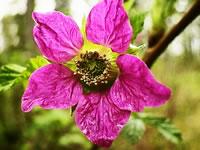Gardening in the Merry Month of May
May's Calendar of Garden Tasks and Projects
The month of May is a time when the weather can either turn your garden into an Eden, or a wasteland. Be aware of the weather forecasts, trends and warnings.

Hardiness zone maps are based on past years averages, and can't predict a freak frost or snowstorm, or a prolonged spring drought. If a frost or cold weather is in the forecast, protect your tender plants with a mulch, newspapers, light cloth or some type of overnight protection or a frost cap made with a roll of poly film tented over the plants. Be sure to remove the plastic tent as soon as the danger of frost is over or your plants will bake in the sun.
If the weather is sunny and dry, don't neglect your watering! Most flowers and shrubs need about an inch of water each week to perform well, and newly planted seedlings especially, will perish if their roots are allowed to dry out.
May is also a time of gardening inspirations and dreams.
Look around yourself and notice what your neighbors are growing in their gardens and what they are creating in their landscapes. Think of how you might utilize some of their ideas along with your own brainstorms to make your garden just a little bit better.
Because the world has such a multitude of microclimates, it would be nearly impossible for me to create a gardening calendar that would cover everyone. Therefore I am writing this monthly list based on general weather patterns for the northern United States (USDA zones 6-8). Most of the information may also be useful for other areas of the world during different months.
Caring for Your Shrubs and Trees
It's still not too late to fertilize your trees and shrubs. Use a Rhododendron or Evergreen type of plant food to feed evergreens and other acid loving plants like Azaleas and Rhododendrons, Camellias and Junipers, etc. Use an all-purpose garden fertilizer (10-10-10) to feed roses, deciduous shrubs and trees. Be sure to water the fertilizer in thoroughly after it is applied.
Early flowering deciduous shrubs such as Forsythias, Weigela, and Spirea should be pruned back when they have finished blooming. Cut back a third of the oldest canes to ground level, then cut back one third of the remaining branches by one third of their height.
Remove the wilting seed heads from Rhododendrons and Azaleas so that the plants energy can go to foliage growth and next years flowers, rather than seeds.
Work lime in the soil around your Hydrangeas to produce pink flowers or Aluminum Sulphate for blue blooms.
Remove any sucker growths from fruit trees as soon as they appear!
Keep a vigilante eye on the roses. Keep them sprayed for aphids and other pests and diseases such as black spot.
Pines and other conifers can be kept to a compact size by pinching off the new growth 'candles'.
Lilacs should be pruned lightly after they finish blooming, removing sucker growths and dead blooms. Feed lilacs in May with a good all purpose 10-10-10 fertilizer after they have finished blooming. If your soil is acidic, work a little lime into the soil as well.
Caring for your Annuals, Perennials and Bulbs
Dahlias, Gladiolas, Lilies, Cannas and other summer flowering bulbs can be planted this month. Gladiolas bulbs may be planted at 2 week increments until the first of July to provide you with cut flowers until the first frost.
Delphiniums, Phlox, Daylilies, Carnations, Aubrietia, Candytuft, Basket of Gold, Primroses, Coral Bells and Saxifrage and other summer flowering perennials may all be set into the garden any time in May.
Break off wilting Tulip or Daffodil heads but continue to feed and care for the plants until the foliage has died back naturally. Old plantings of Daffodils may be divided and moved when they have finished blooming, but treat them as growing plants and use care to protect the foliage and roots. Water them thoroughly after transplanting. It is best not to dig or move other spring flowering bulbs until their foliage has ripened and died back.
Pansies, Snapdragons, Dianthus, Petunias, Geraniums, Fuchsias and Impatiens should be ready to plant by mid month. Toward the end of the month, it should be warm enough to plant out the more tender annuals like Salvia, Zinnias, Marigolds and Cardinal Flowers.
Lightly side dress perennials with an all-purpose 5-10-10 or 10-10-10 fertilizer. Avoid spilling the fertilizer on the plant, and use care not to damage the shallow roots when you cultivate it into the soil.
Setting the stakes next to your taller flowers early in the season, will help to support the plant against winds as well as making it easier to 'train'.
Promptly remove spent flowers from any plant unless your intent is to harvest the seeds. It consumes the plants energy to produce the seeds, and in many species of plants, especially annual plants, removing the dead flowers will promote further blooms.Fruit and Vegetable Gardening
Carrots, Lettuce, Potatoes, Corn, Beans, Peas and most popular vegetables, with the exception of the warmer weather crops, can be seeded or planted into the vegetable garden at any time now. Wait until mid to late May before planting the warmer weather crops like Tomatoes, Squash, cucumber, pumpkins and peppers.
With a little luck, you may begin to see the first fruit on your strawberries by late this month. The birds will enjoy them very much if you don't provide some protective netting over them. Newly planted strawberries should have the blossoms picked off until they become well established.
Gourds can be planted late in the month... if your growing season is long enough.Lawn Care
May is a good month to repair your lawn. Fill in the bare spots by slightly loosening surface of the soil and sow a good quality lawn seed over the area evenly. Tamp the seed in gently and water. Keep the patch moist by covering with light mulch of lawn clippings.
This is the time to eliminate lawn weeds by hand pulling, or the application of a 'weed and feed' fertilizer.... before they go to seed!.
Setting your mower for a higher cut during the spring months will help the grass to grow in fuller and help choke out the weeds.
House Plant Care and Maintenance
Check to see if your house plants are rootbound. Water them thoroughly and carefully remove them from their pots. If the roots have compacted around the outside of the rootball, it is time to repot.
Carefully examine your house plants for pests and problems. It is much easier to fight an insect infestation or disease in it's early stages than to wait....
As the growth rate of your house plants changes with the seasons, adjust your feeding schedule to provide additional food. Feed your plants a good all purpose house plant food at half of the manufacturers recommended rates, increasing the proportion slightly to accommodate growth spurts. Overuse of fertilizers can cause root and foliage burn, as well as the death of the plant.
Mist your plants regularly. This adds to the humidity, keeps the leaves cleaner and healthier, and helps to prevent spider mites.
Gardening Odds and Ends
Slugs and snails are out in full force right now.. and they are ravenous! Be sure to take steps to control them now, before they have a chance to reproduce and devastate your garden.
The first flowers you'll see will be on weeds. Work to eliminate weeds, roots and all, before they have a chance to go to seed, or you will be fighting them for years to come!
If the weather refuses to cooperate with your gardening plans, and your seeds have refused to germinate due to cold and wet conditions, you may want to consider replanting a reserve crop (Just in case....)
The compost pile should be getting a lot of use these days, both in utilizing this free fertilizer, and adding fresh garden refuse to it. The compost pile should be kept damp. Frequent turning will turn your garden waste into flower food much faster.
Salmon Berry Blossom